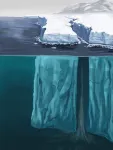80 mph speed record for glacier fracture helps reveal the physics of ice sheet collapse
2024-02-28
(Press-News.org) There’s enough water frozen in Greenland and Antarctic glaciers that if they melted, global seas would rise by many feet. What will happen to these glaciers over the coming decades is the biggest unknown in the future of rising seas, partly because glacier fracture physics is not yet fully understood.
A critical question is how warmer oceans might cause glaciers to break apart more quickly. University of Washington researchers have demonstrated the fastest-known large-scale breakage along an Antarctic ice shelf. The study, recently published in AGU Advances, shows that a 6.5-mile (10.5 kilometer) crack formed in 2012 on Pine Island Glacier — a retreating ice shelf that holds back the larger West Antarctic ice sheet — in about 5 and a half minutes. That means the rift opened at about 115 feet (35 meters) per second, or about 80 miles per hour.
“This is to our knowledge the fastest rift-opening event that's ever been observed,” said lead author Stephanie Olinger, who did the work as part of her doctoral research at the UW and Harvard University, and is now a postdoctoral researcher at Stanford University. “This shows that under certain circumstances, an ice shelf can shatter. It tells us we need to look out for this type of behavior in the future, and it informs how we might go about describing these fractures in large-scale ice sheet models.”
A rift is a crack that passes all the way through the roughly 1,000 feet (300 meters) of floating ice for a typical Antarctic ice shelf. These cracks are the precursor to ice shelf calving, in which large chunks of ice break off a glacier and fall into the sea. Such events happen often at Pine Island Glacier — the iceberg observed in the study has long since separated from the continent.
“Ice shelves exert a really important stabilizing influence on the rest of the Antarctic ice sheet. If an ice shelf breaks up, the glacier ice behind really speeds up,” Olinger said. “This rifting process is essentially how Antarctic ice shelves calve large icebergs.”
In other parts of Antarctica, rifts often develop over months or years. But it can happen more quickly in a fast-evolving landscape like Pine Island Glacier, where researchers believe the West Antarctic Ice Sheet has already passed a tipping point on its collapse into the ocean.
Satellite images provide ongoing observations. But orbiting satellites pass by each point on Earth only every three days. What happens during those three days is harder to pin down, especially in the dangerous landscape of a fragile Antarctic ice shelf.
For the new study, the researchers combined tools to understand the rift’s formation. They used seismic data recorded by instruments placed on the ice shelf by other researchers in 2012 with radar observations from satellites.
Glacier ice acts like a solid on short timescales, but it’s more like a viscous liquid on long timescales.
“Is rift formation more like glass breaking or like Silly Putty being pulled apart? That was the question,” Olinger said. “Our calculations for this event show that it’s a lot more like glass breaking.”
If the ice were a simple brittle material, it should have shattered even faster, Olinger said. Further investigation pointed to the role of seawater. Seawater in the rifts holds the space open against the inward forces of the glacier. And since seawater has viscosity, surface tension and mass, it can’t just instantly fill the void. Instead, the pace at which seawater fills the opening crack helps slow the rift’s spread.
“Before we can improve the performance of large-scale ice sheet models and projections of future sea-level rise, we have to have a good, physics-based understanding of the many different processes that influence ice shelf stability,” Olinger said.
The research was funded by the National Science Foundation. Co-authors are Brad Lipovsky and Marine Denolle, both UW faculty members in Earth and space sciences who began advising the work while at Harvard University.
###
For more information, contact Olinger at solinger@stanford.edu.
END
ELSE PRESS RELEASES FROM THIS DATE:
2024-02-28
CAMBRIDGE, MA -- Perovskites, a broad class of compounds with a particular kind of crystal structure, have long been seen as a promising alternative or supplement to today’s silicon or cadmium telluride solar panels. They could be far more lightweight and inexpensive, and could be coated onto virtually any substrate, including paper or flexible plastic that could be rolled up for easy transport.
In their efficiency at converting sunlight to electricity, perovskites are becoming comparable to silicon, whose manufacture still requires long, complex, and ...
2024-02-28
Scientists from Mass Eye and Ear and the Broad Institute of MIT and Harvard found 18 novel species of a type of bacteria called enterococci, which are gut microbes found in most land animals.
Enterococcus type bacteria are among the leading causes of antibiotic-resistant infections worldwide and 60 species had previously been identified.
Understanding origins of antibiotic-resistant bacteria could offer insight into mechanisms of how drug-resistant, hospital-associated infections take root.
Antibiotic-resistant infection is projected to catch up to cancer as the leading ...
2024-02-28
EMBARGOED FOR RELEASE UNTIL 4 P.M. ET, WEDNESDAY, FEBRUARY 28, 2024
MINNEAPOLIS – For people with drug-resistant epilepsy, having a dog companion trained in detecting seizures and other epilepsy-related tasks may reduce the amount of seizures they have, according to new research published in the February 28, 2024, online issue of Neurology®, the medical journal of the American Academy of Neurology. For the study, researchers looked at adults with severe epilepsy who have been unable to find effective treatment to reduce seizures.
“Despite the development of numerous anti-seizure medications over the past 15 years, up to 30% of people ...
2024-02-28
EMBARGOED FOR RELEASE UNTIL 4 P.M. ET, WEDNESDAY, FEBRUARY 28, 2024
MINNEAPOLIS – For children and teens, irregular meals such as skipped breakfasts are linked to an increased risk of frequent headaches, according to a new study published in the February 28, 2024, online issue of Neurology®, the medical journal of the American Academy of Neurology. The study also found that for those ages 12 to 17, substance use and exposure, specifically electronic cigarettes (e-cigarettes), were associated with frequent headaches.
For the study, frequent headaches were defined as occurring more than once per week.
“It ...
2024-02-28
EMBARGOED FOR RELEASE UNTIL 4 P.M. ET, WEDNESDAY, FEBRUARY 28, 2024
MINNEAPOLIS – For people with stroke, social factors such as education, neighborhood and employment, may be linked to whether they receive treatment with clot-busting drugs according to a preliminary study released today, February 28, 2024, that will be presented at the American Academy of Neurology’s 76th Annual Meeting taking place April 13–18, 2024, in person in Denver and online. The study looked at people with ischemic stroke, which ...
2024-02-28
“Our study introduces an oxidative stress-based prognostic model for bladder cancer, offering insights into personalized therapy.”
BUFFALO, NY- February 28, 2024 – A new research paper was published in Aging (listed by MEDLINE/PubMed as "Aging (Albany NY)" and "Aging-US" by Web of Science) Volume 16, Issue 3, entitled, “Prognostic model development and molecular subtypes identification in bladder urothelial cancer by oxidative stress signatures.”
Mounting studies indicate that oxidative stress (OS) significantly ...
2024-02-28
BUFFALO, N.Y. — Drug discovery can be a frustrating process of trial and error.
Scientists using fragment-based drug discovery link fragments of different molecules together to create a more potent drug but may not know whether a compound works until millions of dollars in research and development have already been spent.
New University at Buffalo research may offer a more streamlined approach, allowing drug makers to determine the viability of a fragment-based design earlier in the process.
While developing a fragment-based drug to treat lung cancer, a team co-led by UB found that where they linked fragments together had a large effect on potency.
“Despite ...
2024-02-28
In a first-of-its-kind study published in the American Journal of Respiratory and Critical Care Medicine, physician-scientists from the University of Alabama at Birmingham Marnix E. Heersink School of Medicine discovered that high-dose inhaled nitric oxide therapy may improve oxygenation and reduce the risk of mortality among critically ill Black patients with COVID-19.
Acute respiratory distress syndrome, or ARDS, is a condition that most commonly occurs in the setting of a lung infection such as COVID-19.
“In ARDS, the barrier between the blood vessels and air sacs in the lungs is disrupted leading to the accumulation of fluid ...
2024-02-28
New Orleans, LA. – Ochsner Digital Medicine has partnered with Humana Healthy Horizons to provide digital medicine services to its members. This agreement was effective February 1, 2024, with member enrollment in digital programs available immediately after.
Humana Healthy Horizons is Humana’s Medicaid plan for Louisiana, covering thousands of members throughout the state. Through this partnership, Ochsner Digital Medicine will offer Humana Healthy Horizons members who have been diagnosed with Hypertension and Type 2 diabetes remote programs designed to manage and control their conditions.
The programs use remote patient management through digital devices and personalized ...
2024-02-28
Seattle is routinely listed as one of the most walkable and bike-friendly cities in the nation. The city government has committed to Vision Zero, which aims to completely eliminate traffic deaths and serious injuries by 2030, and embarked on a slew of infrastructure projects: expanding the city’s bike network, redesigning high-crash intersections and enhancing crosswalks to protect pedestrians.
Such safety projects sometimes meet opposition from local business owners, who worry that reduced parking and disruption ...
LAST 30 PRESS RELEASES:
[Press-News.org] 80 mph speed record for glacier fracture helps reveal the physics of ice sheet collapse






